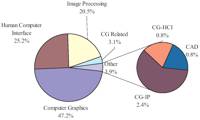
Computer Graphics Education in Different Curricula: Analysis and Proposal for Courses
Eric Paquette
Computers & Graphics, 29(2), pages 245-255, Elsevier, 2005.

|
Computer Graphics Education in Different Curricula: Analysis and Proposal for CoursesEric Paquette Computers & Graphics, 29(2), pages 245-255, Elsevier, 2005. |
This paper studies how Computer Graphics is taught and proposes a course on 2D Computer Graphics and Image Processing as an alternative to the traditional 3D Computer Graphics course. This unconventional course is motivated by an analysis of more than 70 Computer Science curricula. This analysis considers many aspects: Computer Graphics, Image Processing, and Human-Computer Interaction courses; curricula such as Computer Engineering, Computer Science, Information Technology, and Software Engineering; the difference between introductory and advanced courses; and universities known for their leadership in Computer Graphics as well as mainstream universities. The analysis suggests that given the different types of universities and curricula, there should be more alternative courses tailored to the needs of particular curricula. Developing such courses can be difficult and time consuming, so a methodology is proposed to describe a course with information useful for others who could be selecting it or who could be putting it in practice. This methodology is put in practice with the description of a course on 2D Computer Graphics and Image Processing.
@Article{Paquette:2005:CGE,
author = "Eric Paquette",
title = "Computer Graphics Education in Different Curricula: Analysis and Proposal for Courses",
journal = "Computers {\&} Graphics",
pages = "245--255",
volume = 29,
number = 2,
year = "2005",
}
Adobe PDF version of the paper, 230Kb.
